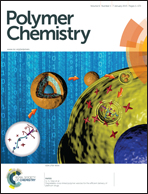Thiol–bromo click polymerization for multifunctional polymers: synthesis, light refraction, aggregation-induced emission and explosive detection
Abstract
New multifunctional polymers PI and PII are synthesized from 4,4′-thiodibenzenethiol and 1,2-bis[4-(bromoalkoxy)phenyl]-1,2-diphenylethene through facile thiol–bromo click polymerization. The resulting polymers exhibit high refractive indices over a wide spectral region (300–1700 nm) and large Abbé numbers due to the presence of sulfur atoms and a large fraction of aromatic building blocks. The polymers also show high optical transparency in the visible region, rendering them ideal candidates for optical applications. Additionally, they demonstrate typical aggregation-induced emission (AIE) characteristics owing to the incorporation of propeller-like tetraphenylethene (TPE) moieties. The polymers are nonemissive in good solvents; however, they become highly fluorescent as aggregated suspensions whose emission is further effectively quenched by a representative explosive of picric acid (PA), exhibiting a significantly amplified superquenching effect, with the detection limit as low as 0.5 ppm. These results suggest a great promise of preparing multifunctional polymers by thiol–bromo click polymerization with a rational molecular design.


 Please wait while we load your content...
Please wait while we load your content...